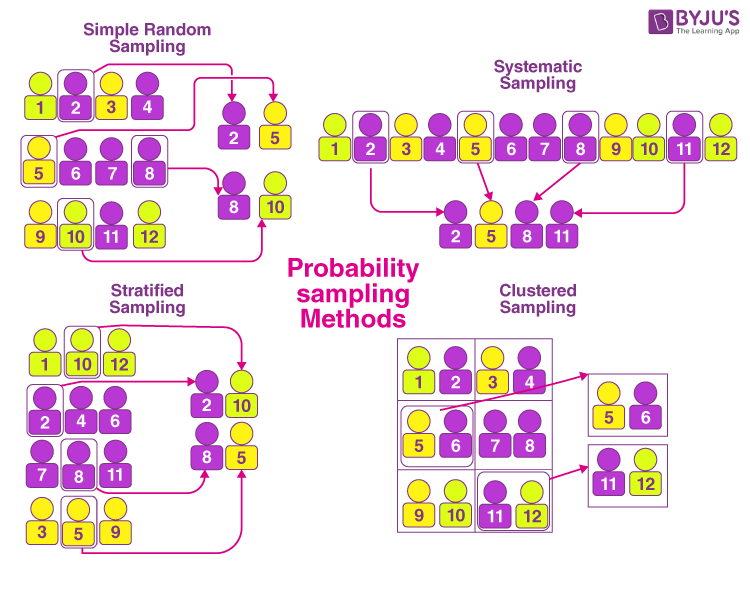We know that statistical research helps in drawing several conclusions based on the requirement of the experts. This uses the data collected for a specific purpose. We can collect the data using various sampling methods in statistics. However, the type of sampling method is chosen based on the objective of the statistical research. The statistical research is of two forms:
- In the first form, each domain is studied, and the result can be obtained by computing the sum of all units.
- In the second form, only a unit in the field of the survey is taken. It represents the domain. The result of these samples extends to the domain. This type of study is known as the sample survey.
In this article, let us discuss the different sampling methods in research such as probability sampling and non-probability sampling methods and various methods involved in those two approaches in detail.

| Table of Contents: |
What are the sampling methods or Sampling Techniques?
In Statistics, the sampling method or sampling technique is the process of studying the population by gathering information and analyzing that data. It is the basis of the data where the sample space is enormous.
There are several different sampling techniques available, and they can be subdivided into two groups. All these methods of sampling may involve specifically targeting hard or approach to reach groups.
Types of Sampling Method
In Statistics, there are different sampling techniques available to get relevant results from the population. The two different types of sampling methods are::
- Probability Sampling
- Non-probability Sampling

Also, read: Sample statistic
What is Probability Sampling?
The probability sampling method utilizes some form of random selection. In this method, all the eligible individuals have a chance of selecting the sample from the whole sample space. This method is more time consuming and expensive than the non-probability sampling method. The benefit of using probability sampling is that it guarantees the sample that should be the representative of the population.
Probability Sampling Types
Probability Sampling methods are further classified into different types, such as simple random sampling, systematic sampling, stratified sampling, and clustered sampling. Let us discuss the different types of probability sampling methods along with illustrative examples here in detail.
Simple Random Sampling
In simple random sampling technique, every item in the population has an equal and likely chance of being selected in the sample. Since the item selection entirely depends on the chance, this method is known as “Method of chance Selection”. As the sample size is large, and the item is chosen randomly, it is known as “Representative Sampling”.
Example:
Suppose we want to select a simple random sample of 200 students from a school. Here, we can assign a number to every student in the school database from 1 to 500 and use a random number generator to select a sample of 200 numbers.
Systematic Sampling
In the systematic sampling method, the items are selected from the target population by selecting the random selection point and selecting the other methods after a fixed sample interval. It is calculated by dividing the total population size by the desired population size.
Example:
Suppose the names of 300 students of a school are sorted in the reverse alphabetical order. To select a sample in a systematic sampling method, we have to choose some 15 students by randomly selecting a starting number, say 5. From number 5 onwards, will select every 15th person from the sorted list. Finally, we can end up with a sample of some students.
Stratified Sampling
In a stratified sampling method, the total population is divided into smaller groups to complete the sampling process. The small group is formed based on a few characteristics in the population. After separating the population into a smaller group, the statisticians randomly select the sample.
For example, there are three bags (A, B and C), each with different balls. Bag A has 50 balls, bag B has 100 balls, and bag C has 200 balls. We have to choose a sample of balls from each bag proportionally. Suppose 5 balls from bag A, 10 balls from bag B and 20 balls from bag C.
Clustered Sampling
In the clustered sampling method, the cluster or group of people are formed from the population set. The group has similar significatory characteristics. Also, they have an equal chance of being a part of the sample. This method uses simple random sampling for the cluster of population.
Example:
An educational institution has ten branches across the country with almost the number of students. If we want to collect some data regarding facilities and other things, we can’t travel to every unit to collect the required data. Hence, we can use random sampling to select three or four branches as clusters.
All these four methods can be understood in a better manner with the help of the figure given below. The figure contains various examples of how samples will be taken from the population using different techniques.
What is Non-Probability Sampling?
The non-probability sampling method is a technique in which the researcher selects the sample based on subjective judgment rather than the random selection. In this method, not all the members of the population have a chance to participate in the study.
Non-Probability Sampling Types
Non-probability Sampling methods are further classified into different types, such as convenience sampling, consecutive sampling, quota sampling, judgmental sampling, snowball sampling. Here, let us discuss all these types of non-probability sampling in detail.
Convenience Sampling
In a convenience sampling method, the samples are selected from the population directly because they are conveniently available for the researcher. The samples are easy to select, and the researcher did not choose the sample that outlines the entire population.
Example:
In researching customer support services in a particular region, we ask your few customers to complete a survey on the products after the purchase. This is a convenient way to collect data. Still, as we only surveyed customers taking the same product. At the same time, the sample is not representative of all the customers in that area.
Consecutive Sampling
Consecutive sampling is similar to convenience sampling with a slight variation. The researcher picks a single person or a group of people for sampling. Then the researcher researches for a period of time to analyze the result and move to another group if needed.
Quota Sampling
In the quota sampling method, the researcher forms a sample that involves the individuals to represent the population based on specific traits or qualities. The researcher chooses the sample subsets that bring the useful collection of data that generalizes the entire population.
Learn more about quota sampling here.
Purposive or Judgmental Sampling
In purposive sampling, the samples are selected only based on the researcher’s knowledge. As their knowledge is instrumental in creating the samples, there are the chances of obtaining highly accurate answers with a minimum marginal error. It is also known as judgmental sampling or authoritative sampling.
Snowball Sampling
Snowball sampling is also known as a chain-referral sampling technique. In this method, the samples have traits that are difficult to find. So, each identified member of a population is asked to find the other sampling units. Those sampling units also belong to the same targeted population.
Probability sampling vs Non-probability Sampling Methods
The below table shows a few differences between probability sampling methods and non-probability sampling methods.
| Probability Sampling Methods | Non-probability Sampling Methods |
| Probability Sampling is a sampling technique in which samples taken from a larger population are chosen based on probability theory. | Non-probability sampling method is a technique in which the researcher chooses samples based on subjective judgment, preferably random selection. |
| These are also known as Random sampling methods. | These are also called non-random sampling methods. |
| These are used for research which is conclusive. | These are used for research which is exploratory. |
| These involve a long time to get the data. | These are easy ways to collect the data quickly. |
| There is an underlying hypothesis in probability sampling before the study starts. Also, the objective of this method is to validate the defined hypothesis. | The hypothesis is derived later by conducting the research study in the case of non-probability sampling. |
For more information on Statistics concepts, stay tuned with BYJU’S- The Learning App and explore more videos.
Frequently Asked Questions on Sampling Methods
What are sampling methods in statistics?
Probability Sampling Methods
Non-probability Sampling methods
What are the methods of probability sampling?
Simple Random Sampling
Systematic Sampling
Stratified Sampling
Clustered Sampling
What are the non-probability sampling methods?
Convenience Sampling
Consecutive Sampling
Quota Sampling
Purposive or Judgmental Sampling
Snowball Sampling
What is an example of simple random sampling?
Selection of a simple random sample of 50 female employees in an organization out of 1000 female employees: Here, we can assign a number to every female employee 1 to 1000 and use a random number generator to select 50 numbers. Thus, we can get a sample of 50 female employees.

